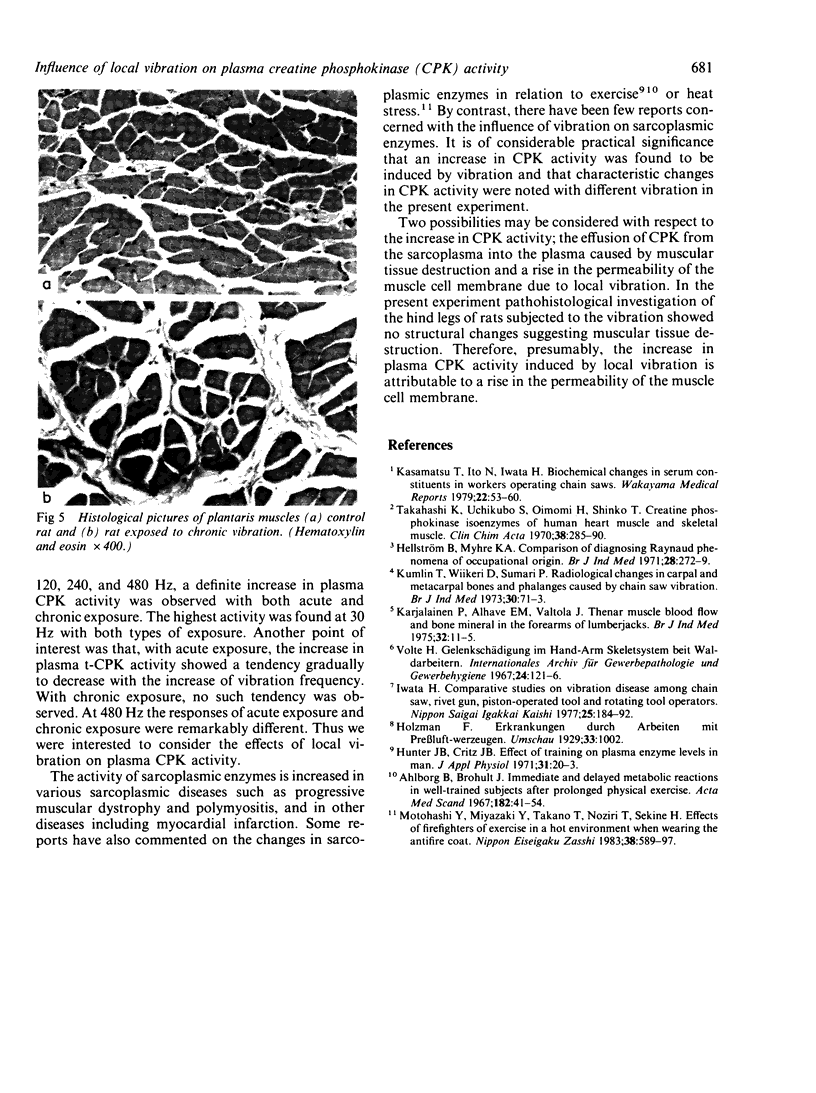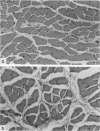Abstract
This study was designed to obtain basic information about the mechanism of the occurrence of muscular disorders after exposure to vibration. The hind legs of rats were exposed to acute and chronic local vibration at frequencies of 30, 60, 120, 240, 480, and 960 Hz with a constant acceleration of 50 m/sec2. The exposure time was four hours for acute, and four hours a day for two weeks continuously for chronic exposure. Blood was collected after exposure to measure plasma creatine phosphokinase (CPK) activity. In both exposure groups the activity of plasma CPK was significantly higher at 30, 60, 120, 240, and 480 Hz compared with the control group and was especially high at 30 Hz; there was no significant change at 960 Hz. As a result of an analysis of the CPK isoenzymes, the increase in plasma CPK activity was shown to be due to the activity of the plasma CPK-MM fraction, originating in the skeletal muscle. Plasma CPK activity showed a tendency to decrease gradually with the increase in vibration frequency during acute exposure but showed no such tendency during chronic exposure. There was no remarkable pathohistological change in muscle preparations from the hind legs, hence it was presumed that the increase in plasma CPK activity was caused not by the morphological changes of muscle but by other mechanisms, such as an increase in the permeability of the cell membrane.
Full text
PDF



Images in this article
Selected References
These references are in PubMed. This may not be the complete list of references from this article.
- Ahlborg B., Brohult J. Immediate and delayed metabolic reactions in well-trained subjects after prolonged physical exercise. Acta Med Scand. 1967 Jul;182(1):41–54. doi: 10.1111/j.0954-6820.1967.tb11498.x. [DOI] [PubMed] [Google Scholar]
- Hellstrom B., Myhre K. A comparison of some methods of diagnosing Raynaud phenomena of occupational origin. Br J Ind Med. 1971 Jul;28(3):272–279. doi: 10.1136/oem.28.3.272. [DOI] [PMC free article] [PubMed] [Google Scholar]
- Karjalainen P., Alhava E. M., Valtola J. Thenar muscle blood flow and bone mineral in the forearms of lumberjacks. Br J Ind Med. 1975 Feb;32(1):11–15. doi: 10.1136/oem.32.1.11. [DOI] [PMC free article] [PubMed] [Google Scholar]
- Kumlin T., Wiikeri M., Sumari P. Radiological changes in carpal and metacarpal bones and phalanges caused by chain saw vibration. Br J Ind Med. 1973 Jan;30(1):71–73. doi: 10.1136/oem.30.1.71. [DOI] [PMC free article] [PubMed] [Google Scholar]
- Motohashi Y., Miyazaki Y., Takano T., Noziri T., Sekine H. [Effects of exertion in a hot environment on firefighters wearing fire-proofed garment]. Nihon Eiseigaku Zasshi. 1983 Jun;38(2):589–597. [PubMed] [Google Scholar]
- Takahashi K., Ushikubo S., Oimomi M., Shinko T. Creatiine phosphokinase isoenzymes of human heart muscle and skeletal muscle. Clin Chim Acta. 1972 May;38(2):285–290. doi: 10.1016/0009-8981(72)90117-9. [DOI] [PubMed] [Google Scholar]



